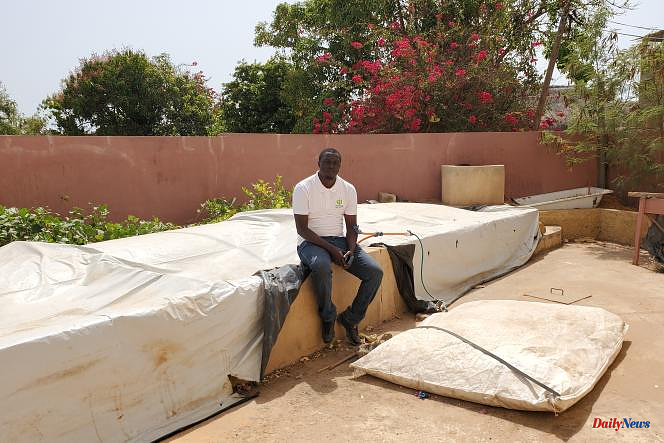His neighbors thought he was crazy. When Cheikhou Thiome explained to them that he could create gas from the remains of a thieboudiene or a yassa, "they didn't want to believe [it]", recalls the 59-year-old English teacher . Next to the entrance to his house still under construction, where a few hens are pacing, he installed an inflatable object in 2020 that seems alive as it gurgles.
A pipe escapes from this black machine, crosses the concrete block wall of the building to connect a stove that sits in the center of the kitchen. For half an hour, his wife has been preparing a domoda – a Senegalese stew – on this plate for their five children. “We have unlimited gas,” enthuses Mr. Thiome. And now all our neighbors envy us. »
Three years ago, this resident of Yenne, a village on the small coast located 40 kilometers southeast of Dakar, wanted to equip himself with a device that can produce biogas, only from organic waste. or cow dung. "I was looking for a way to reduce my family's carbon footprint," he explains. A friend who lives in the United States gave me this digester. And, since then, he no longer throws anything or very little.
Thanks to this process called methanisation, peelings, spoiled vegetables or fruits, frying oil and leftovers from everyday meals come to "feed" the system in which bacteria transform food into energy. And the hotter it is, the more they develop. "With 2 kg of waste, you can use 2 hours of gas a day," he says.
"Recover" household waste
To install this device, Mr. Thiome called on Pape Assane Ndao, an engineer who heads Methanizer Afrique, a small structure with big ambitions. Precisely, that noon, the thirty-year-old with shyness as imposing as his build came to inspect the machine: a few months ago, it had a small problem of "indigestion": "The parents had delegated the task of feed the device to children who put anything in it, he says. It wasn't much, a domestic methanizer has a 20-year lifespan. »
For seven years, Pape Assane Ndao has been crisscrossing Senegal with his team of three, especially in rural areas, to sell these devices that come from Europe. "In town, we always prefer gas cylinders," he breathes. The man in the white polo shirt believes in the virtue of digesters, preaches their quality with disconcerting conviction. Since childhood, he has been concerned with environmental issues, particularly those relating to energy.
A graduate in electromechanics, it was in France that he trained in methanisation. “More than ten years ago, I had made a digester with elements recovered here and there. It was doing well,” he recalls. In 2017, he honors his first order. Today, he installs around fifty a year in the four corners of Senegal. “There are about ten Senegalese companies in our sector,” he notes.
Pape Assane Ndao would like to change the "cooking habits" of the Senegalese. To achieve this, it seeks to "value" household waste, which reached 658,933 tonnes in 2020 in the Dakar region (some 170 kg per inhabitant). "When I look at a garbage can full of food, I think it's wasted gas," he says. We lose energy when we do not create it. His dream is for every family to be self-sufficient in cooking gas. "I don't want us to use coal or firewood anymore, it's a source of deforestation and it's not good for your health," says the engineer.
"Biogas is more calorific"
The huge obstacle remains above all the price. A digester costs at least 400,000 CFA francs (about 600 euros), more than six times the Senegalese minimum wage, but "in the long term, it is very profitable", insists Pape Assane Ndao. "Because biogas is more calorific, it gives off more heat and therefore cooking a dish is faster," he says. "And we spend less money," adds Cheikhou Thiome. And in this period of inflation [9.4% in February 2023], that relieves me. »
Before owning a home biogas plant, the English teacher bought two 12 kg gas cylinders per month (6,680 CFA francs each), "now I use one every six months," he explains. he. Thus, in three years, Mr. Thiome saved nearly 440,000 CFA francs, the price of a digester. And, with this money, he can continue to pay for the work on his house.
Fifteen kilometers further south, Pape Assane Ndao goes to a youth center in Popenguine, a small seaside resort. Very close to the swimming pool, in a corner of the establishment which can accommodate 80 children, he installed a huge digester in 2022 for the price of 1.5 million CFA francs (about 2,300 euros). However, the device could not be connected directly to the kitchen. The gas is therefore transported in bags that can be connected to the hobs, but all of them are pierced and Pape Assane Ndao can do nothing but advise to buy more.
Another limit to its use: "The digester is full of gas and there is no one to recover it, regrets Alassane Diagne, 34, the center coordinator. We don't have that reflex yet. But the most important thing is not there according to him: “We wanted to reduce our waste and prove to the locality that it was possible. We want to encourage other people to get a methanizer so that the garbage disappears from our common area. The digester allows us to educate our young people on the issue of the environment, sorting and renewable energies. »
Alassane Diagne has another project for his digester: dismantling it to install it on agricultural land that he aims to acquire. Indeed, the device also produces natural liquid fertilizer, ideal for crops. "Anaerobic digestion is still poorly understood in Senegal and the rest of Africa," explains Pape Assane Ndao. There is no training school for this technology. »
In December 2009, the Senegalese State launched the national domestic biogas program with the objective of installing 8,000 digesters in three years. By 2021, 2,309 digesters had been installed across the country.












